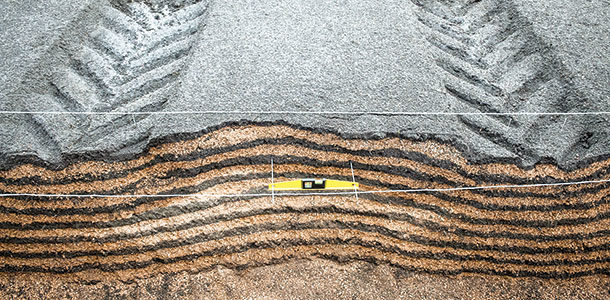Advances in seed and precision-farming technologies are continuing to drive higher productivity and crop yields. Farmers are looking for any edge they can gain, and that’s especially true for dairy producers during times of lower milk prices.
Research has shown that one of the most effective means of improving crop production is to reduce soil compaction. In recent years, tractors, sprayers and combines have all gotten larger. This trend toward bigger, heavier equipment has helped farmers cover more acres in less time – but often at the cost of increased compaction that can dramatically reduce crop production and yield performance.
Dairy producers who grow their own silage face the same challenge as other farmers. Liquid manure spreaders used on dairy farms are often the biggest cause of soil compaction due to their heavy axle load.
An industry report noted that a large two-axle manure spreader can weigh 30 tons (15 tons per axle, including the weight of manure), while research has shown that an axle load of only 10 to 12 tons can cause soil compaction of at least 20 inches deep with a first-year yield loss of about 15 percent.
When heavy equipment compresses the soil, the result can be restricted root growth, poor nutrient intake and stunted plant development, all of which can lead to lost yield. Compacted soil can also cause moisture runoff and soil erosion, taking a toll on environmental quality.
Benefits of low-pressure tires
Heavy equipment, however, is only part of the equation. Contact pressure from equipment tires on the soil surface is another primary cause of soil compaction. Numerous studies have shown the benefits of IF (increased flexion) and VF (very high flexion) tires that can operate at a lower air pressure under increased loads compared to standard radial tire technology.
Today’s latest tire technologies enable farmers to carry up to a 40 percent heavier load at the same air pressure compared to standard radial technology – or the same load at 40 percent lower pressure.
Reduced pressure results in a larger footprint, spreading the weight of the machine over a larger area to reduce compaction. The larger footprint also allows for better traction in the field, less slippage and improved fuel economy.
Recent research has illustrated how designing agricultural tires to work at lower pressure can improve soil protection and thereby boost crop yields. For example, researchers at Harper Adams University in the UK studied the productivity gains achieved on sample wheat plots over the past three years using farm machinery equipped with VF tires compared to standard radial tires.
The study revealed a yield increase of up to 4 percent. Similar studies involving other crops in different environments are expected to be conducted in the near future.
Tires vs. tracks
A common question is: Which creates the least amount of compaction – tires or tracks? Much of the research reveals no significant difference.
Research cited in a University of Minnesota Extension report noted that tractors equipped with either tracks or radial tires create compaction in the top 5 to 8 inches of soil, while deeper, subsurface compaction can occur with heavier field equipment, such as combines or grain carts. According to the report, whether the equipment uses tracks or tires, the total axle load is nearly the same.
An Ohio State University study involving two different-sized tractors also reported no significant difference between tires and tracks, and that air pressure instead was a determining factor.
It found that a tractor with overinflated dual tires (24 psi) caused the most compaction, while the least compaction was caused by a tractor with properly inflated (6 psi) duals. As reported in a Penn State Extension report, this study showed that “duals can do as good a job in avoiding topsoil compaction as tracks, provided the tire pressure is kept low.”
While tire compaction is applied primarily at the surface level, higher axle loads create compaction down into the subsoil, which is a critical area for storing moisture and supporting deep root growth. According to the Penn State Extension report, deep subsurface compaction is permanent and should be avoided at all costs by keeping axle loads below 10 tons and preferably below 6 tons.
Managing compaction
The best way to protect crop yield and feed quality is to be aware of the factors that cause soil compaction and take steps to minimize it. Here are recommendations that can help boost dairy farm productivity, feed quality and profitability.
- Compaction is greatest in wet soil since driving on it causes slippage, ruts and deep compression. If possible, delay field work for a few days to allow the ground to dry longer, since drier soil is better able to withstand high axle loads and tire pressure. However, there may be an economic trade-off to take into consideration since delays in planting or harvesting might have more significant consequences than compaction.
- Decreasing axle load and using tires that can operate at lower air pressure are two of the most important ways to reduce compaction. Utilize equipment that is as light as possible for your operation yet still efficient in transferring horsepower to the ground without slippage.
- Use radial rather than bias tires, and duals to replace singles to further distribute machine weight. Larger-diameter tires can help increase the length of the footprint to decrease tire contact pressure.
- Where possible, minimize the number of trips over the field and reduce the area of your field that is touched by equipment.
- Controlled traffic is also an effective way to manage compaction. This involves limiting heavy machinery to the same lanes through the field, year after year. The lanes become compacted, but machinery is never operated on the soil between the lanes. This is a very common practice in Europe and has been proven to increase yield by minimizing compaction.
Protecting the soil is one of the best investments farmers can make in maximizing crop performance and yield potential. While it may not be possible to avoid compaction entirely, it can be successfully managed with the right equipment and proper management practices. PD
James Crouch is farm segment marketing manager for Michelin North America Agricultural Tires.
References omitted due to spacebut are available upon request. Click here to email an editor.
PHOTO
In this compaction test, a pit with different-colored layers of soil shows less soil compaction with a VF tire on the left that can operate at lower pressure compared to a standard radial technology tire on the right.Photo courtesy of James Crouch.







